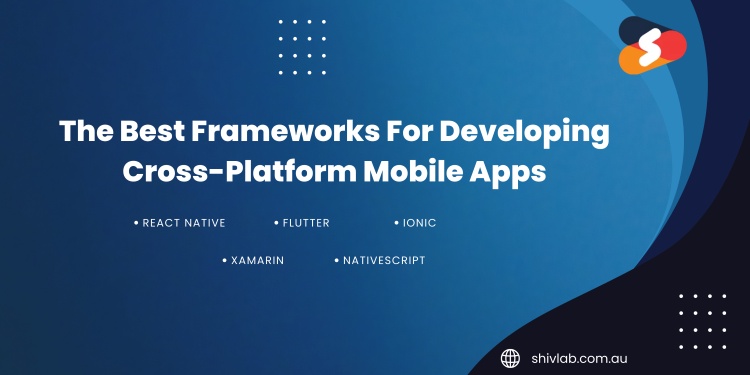Cross-platform software is software that can run on multiple platforms, such as Android, iOS and Windows. Cross-platform apps do not require separate programming for each platform. Instead, coding once will allow the app to run on all platforms. This is a very popular method in app development today and it is used by almost all top mobile app development companies.
The code must be written once by developers. Cross-platform platform app development platforms will handle the rest to create an enterprise-level app that is user-friendly and easy to use. Flutter and Xamarin are terms that every CTO, entrepreneur, and executive has heard. Flutter and Xamarin both have a strong reputation as cross-platform app development platforms.
This blog will discuss the best cross-platform apps development frameworks.
Best Frameworks For Developing Cross-Platform Mobile Apps
These are some of the most popular cross-platform apps development platforms,
React Native
React Native is a cross-platform framework that can be used to create apps. React Native is a JavaScript-based framework that is used to create real code and give mobile apps a native feel. It works on both Android and iOS. React Native is a popular choice for developers, but it also has many benefits that businesses trust.
React Native combines the best of JavaScript and React.JS with the ability to create modules in Objective-C or Swift. React Native Developers can perform complex operations, such as image editing or video processing, using React Native cross platform apps.
Features
React Native, an open-source cross platform app framework similar to Ionic, is a great thing. It has a large community that supports it and helps to improve it.
Cross-platform development has the advantage of requiring one-time programming (WORA), to develop apps for multiple platforms such as Android and iOS. This eliminates the problem of other frameworks, which requires developers to code twice for the same app on different platforms.
React Native app development costs are lower and one-time coding reduces development time by up to 50%.
React Native works well with third-party plugins like Google Maps.
React Native is a UI-first platform that renders a responsive interface. React Native reduces loading time and provides a seamless interface to applications.
Flutter
In 2017, Google launched Flutter, a cross-platform app framework. It's a software development tool that facilitates the rapid development of iOS and Android apps. It is the primary and fundamental method of developing Google Fuschia applications.
Flutter allows apps to run easily on multiple platforms, with uniformity and dynamicity.
These are just a few of the amazing features that make Flutter a great cross-platform platform framework for developers.
Features
Flutter advocates a portable GPU that renders UI power and allows it to work with the most recent interfaces.
Flutter doesn't require you to manually update the UI content, since it uses a reactive framework. Flutter app developers only need to update variables. UI changes will then be visible.
The Flutter cross-platform application framework is a great choice for developing Minimum Viable Products (MVP), as it facilitates a speedy development process and is cost-efficient.
Developers can quickly and efficiently create a widget tree from scratch.
Flutter comes with an integrated graphic engine. These features mean that developers don't have to create separate interfaces for iOS and Android.
Ionic
The Ionic framework can create robust apps regardless of whether you are a startup or large business. According to an official survey, Ionic powers up to 10% of the apps in the Apple App Store and 16% of the apps in the Google Play Store. Although Flutter and React Native are popular frameworks, Ionic gained popularity quickly among entrepreneurs and developers after it was launched in 2011.
Ionic developers can be hired to create hybrid apps that look and feel like native apps. It is based upon Angular JS, along with other web technologies such as HTML, CSS and JavaScript, to create enterprise apps, progressive web apps (PWAs), mobile apps and desktop apps. Ionic is known for its ready-to-use components.
Features
It is an open-source front end framework that allows for modifications to the code structure. This makes it suitable for every developer and saves time. It is a strong competitor to Ionic in the battle for React Native vs Ionic.
Ionic is built on a SAAS UI framework specifically designed for mobile operating systems. It includes many UI components that can be used to develop robust applications.
Another feature that is highly appreciated is its AngularJS base. This allows you to add extensions to HTML's syntax and core functionalities, allowing you to embed useful, yet attractive, features and components into your app.
This framework makes use of Cordova plugins, which give access to the in-built features of devices like Camera, GPS and Audio Recorder. It is one of the main benefits of cross-platform development tools.
Ionic is a popular choice for developers because it gives the apps a natural feel. It allows developers to create cross-platform apps that can run on different platforms.
Xamarin
Xamarin, a cross-platform, streamlined framework, was launched in 2011 as an independent, open-source and flexible platform. Xamarin app development allows you to develop apps for Android, iOS and Windows. Xamarin allows developers to reuse up to 90% of their code. This can dramatically reduce development costs and time to market. Your company will have a huge advantage over its competitors.
Xamarin is a framework that is much easier than Flutter and React Native. Anyone who has a basic knowledge of.net or C# can learn Xamarin. It is also easy to link Xamarin to native libraries, so developers can customize the app and give it native functionality.
Features
Apps built on the Xamarin framework use C# - a modern cross-platform app development language that has advantages over Objective-C or Java.
Xamarin gives developers native-level app functionality. It helps to reduce hardware compatibility issues by using plugins and APIs that work with common device functionality. It is a top-rated framework for Android app development.
Xamarin allows direct inclusion of Objective C, Java, and C++ libraries. This allows developers to reuse numerous third-party codebases that are encrypted in Java, Objective-C, or C++. It is one of the most popular cross-platform frameworks.
Xamarin helps reduce the time and costs of developing mobile apps. It supports WORA (Write Once, Run Anywhere) as well as a huge collection of class libraries.
Xamarin provides robust compile time checking. This facility allows developers to see fewer errors during runtime and create well-functioning apps.
Xamarin offers a stunning native user interface that allows developers to create native-like apps.
NativeScript
NativeScript is a free, cross-platform framework that uses JavaScript. NativeScript is a great choice for developers who are looking for WORA functionality.
NativeScript offers all native APIs. This allows developers to reuse plugins directly from NPM into their projects.
Features
NativeScript creates beautiful, intuitive, platform-native UI without WebViews. NativeScript can be defined once by developers and then it will adapt to any platform. You can customize the UI for specific screens and devices.
NativeScript, unlike React Native provides developers with a comprehensive web resource loaded with plugins to support all types of solutions. This eliminates the need to use third-party solutions.
NativeScript allows developers to access native Android and iOS APIs easily. This means that they don't have to be familiar with native languages.
It uses TypeScript and Angular for programming purposes.
NativeScript supports segments such as AndroidArsenal or Cocoapods, and calls libraries for local strategies.
Conclusion:
Flutter and React Native are the most popular, followed by Xamarin and Ionic. Cross-platform apps can increase market penetration and automate major processes cost-effectively. These apps will be around for a long period.
Shiv Technolabs has in-house teams that can develop Flutter and React Native apps. Shiv Technolabs offers excellent consulting and dedicated developers to help you with your cross-platform mobile app development project.


No comments yet